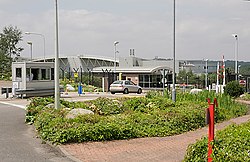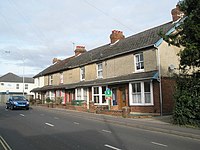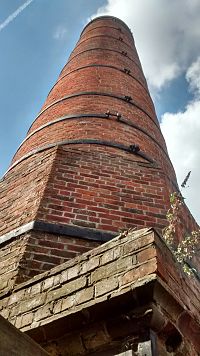Swanwick, Hampshire
| Swanwick | |
| Hampshire | |
|---|---|
 NATS London Area Control Centre, Swanwick | |
| Location | |
| Grid reference: | SU519099 |
| Location: | 50°52’59"N, 1°16’15"W |
| Data | |
| Post town: | Southampton |
| Postcode: | SO31 / PO15 |
| Dialling code: | 01489 |
| Local Government | |
| Council: | Fareham |
| Parliamentary constituency: |
Fareham |
Swanwick is an urbanised village in Hampshire, on the east side of the River Hamble and north of the M27 motorway.
The London Area Control Centre and the London Terminal Control Centre, both part of the National Air Traffic Services Air Traffic Control Centre, are found in Swanwick. Here also are the Bursledon Brickworks, the last remaining example of a Victorian steam-powered brickworks, now a museum.
Swanwick has no real village centre and the only commercial premises of note is the Elm Tree Public House. Since the 1980s, the gradual spread of housing developments has meant that Swanwick has partly merged with the new development of Whiteley although the only direct vehicular access is by way of Yew Tree Drive (once a bus only route).
Swanwick railway station on the West Coastway Line is approximately one mile south of the village and is nearer Park Gate than Swanwick.
The village's "twin" Lower Swanwick is two miles west of the village on the edge of the River Hamble.
History
Peculiar Bronze Age remains have been found at Swanwick: a shaft of that age was found to contain 20 cylindrical loom-weights and a wooden post with organic residues believed to be the remains of flesh and blood,[1] suggestive of ritual use, perhaps the digging of shafts to the underworld. A refuse pit dating from Roman times has also been found at Swanwick.[2]
In the autumn of the year 877, King Alfred the Great blockaded the city of Exeter in order to capture the heathen army occupying the city; some of the Danes fled by sea and were pursued by king's ships to Swanwick where the pagans' boats were sunk after a month at sea.[3] Some historians have debated whether this was at Swanwick in Hampshire, or a coastal settlement called Sanewick in Dorset.[4] Some accounts indicate that the Danes lost some 120 vessels at Swanwick.[5][6]
The Post Office Directory of 1855 listed Swanwick as a hamlet within the parish of Titchfield (itself the largest parish in the county at the time). The hamlet had an independent chapel and four residents were listed: a gentleman by the name of William B Gates, a farmer (John Crosskey), a blacksmith (Richard Hewett) and a grocer (Thomas Privett).[7]
Around the beginning of the 20th century the area around Swanwick was noted for its strawberry beds.[8] Strawberry farming remained a feature of the area, and in 1961 strawberries from Swanwick were being cooled immediately after picking as an experimental way of retaining quality and freshness for longer. Swanwick's cooled strawberries were being transported to markets as far away as Leeds, Manchester and Glasgow.[9]
The air traffic area control centre at Swanwick was brought into operation in 2002.[10]
About the village
The area houses Bursledon Brickworks.
Swanwick Lakes Nature Reserve is an area of about 80 acres that was formed from clay pit excavations. Owned by NATS, the site is managed by the Hampshire and Isle of Wight Wildlife Trust and is a Site of Nature Conservation Interest.[11] Both NATS and the Nature Reserve formed part of the original brickworks.
Outside links
| ("Wikimedia Commons" has material about Swanwick, Hampshire) |
References
- ↑ Milisauskas, Sarunas (2011). European Prehistory: A Survey. pp. 375. https://books.google.com/books?id=gcGSn0eVs2oC&lpg=PA375&dq=Swanwick%20Hampshire&pg=PA375#v=onepage&q=Swanwick%20Hampshire&f=false. Retrieved 11 February 2013.
- ↑ Holbrook, Neil (1991). Roman Finds from Exeter. University of Exeter Press. pp. 298. https://books.google.com/books?id=IFGK4U1PT0cC&lpg=PA298&dq=Swanwick%20Hampshire&pg=PA298#v=onepage&q=Swanwick%20Hampshire&f=false.
- ↑ Evans, John (1824). A Chronological Outline of the History of Bristol, and the Stranger's Guide Through Its Streets and Neighbourhood. pp. 19. https://books.google.com/books?id=_9JCAAAAYAAJ&dq=Swanwick%20Hampshire&pg=PA19#v=onepage&q=Swanwick%20Hampshire&f=false.
- ↑ Roger of Wendover (1849). Flowers of history, 1. pp. 209. https://books.google.com/books?id=TiYRa8nIJYwC&dq=Swanwick%20Hampshire&pg=PA209#v=onepage&q=Swanwick%20Hampshire&f=false.
- ↑ Thomson, Richard (1828). Illustrations of the history of Great Britain. pp. 243. https://books.google.com/books?id=IyUNAAAAYAAJ&dq=Swanwick%20Hampshire&pg=PA243#v=onepage&q=Swanwick%20Hampshire&f=false.
- ↑ ASC 877 - English translation at project Gutenberg. Retrieved 2 May 2013
- ↑ Post Office Directory of Hampshire, Wiltshire, and Dorsetshire. The Post Office. 1855. pp. 161, 162. https://books.google.com/books?id=0uUNAAAAQAAJ&dq=Swanwick%20Hampshire&pg=PA161#v=onepage&q=Swanwick%20Hampshire&f=false. Retrieved 11 February 2013.
- ↑ Brown, Jonathan (1987). Agriculture in England: A Survey of Farming, 1870-1947. pp. 51. https://books.google.com/books?id=DXa7AAAAIAAJ&lpg=PA51&dq=Swanwick%20Hampshire&pg=PA51#v=onepage&q=Swanwick%20Hampshire&f=false.
- ↑ "Cooled strawberries travel better". New Scientist: 767. 29 June 1961. https://books.google.com/books?id=8U3p9H1BxhsC&lpg=PA767&dq=Swanwick%20Hampshire&pg=PA767#v=onepage&q=Swanwick%20Hampshire&f=false. Retrieved 11 February 2013.
- ↑ Khurana, K. C. (2009). Aviation Management: Global Perspectives. pp. 25. https://books.google.com/books?id=ESWo4Zl5g1IC&lpg=PA25&dq=Swanwick%20Hampshire&pg=PA25#v=onepage&q=Swanwick%20Hampshire&f=false.
- ↑ "Swanwick Lakes". Hampshire and Isle of Wight Wildlife Trust. Archived from the original on 11 February 2013. http://www.webcitation.org/6ELlweivg. Retrieved 11 February 2013.

